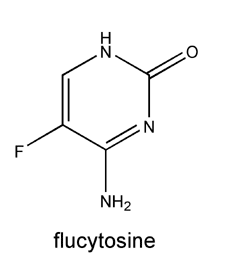Trade & Generic Names
Flucytosine (5-fluorocytosine; 5-FC; 4-amino-5-fluoro-2-pyrimidone) is an antimetabolite type of antifungal drug. It is chemically a pyrimidine. It is activated by deamination within the fungal cells to 5-fluorouracil. Flucytosine is marketed as AncobonTM by Roche Laboratories. It is available as oral capsules since 1972 in USA. Its intravenous formulation is no longer available.

Mechanism(s) of Action
Flucytosine is the the only available antimetabolite drug having antifungal activity. It inhibits fungal protein synthesis by replacing uracil with 5-flurouracil in fungal RNA. Flucytosine also inhibits thymidylate synthetase via 5-fluorodeoxy-uridine monophosphate and thus interferes with fungal DNA synthesis [219, 2055].
Susceptibility Patterns
Flucytosine is active against Candida spp., Cryptococcus neformans, Aspergillus spp. and the dematiaceous fungi, Phialophora spp. and Cladosporium spp. causing chromoblastomycosis [219, 1469].
While flucytosine is in clinical use for these few specific indications, its use alone in treatment frequently results in emergence of resistance. Resistance is usually mediated by mutations in cytosine permease or cytosine deaminase enzymes [1819]. Thus, flucytosine is almost always administered with amphotericin B [597] or fluconazole [1471] or with both amphotericin B and fluconazole [586, 1143] as combination therapy. Amphotericin B and flucytosine combination has proven to be favorable in treatment of cryptococcal meningitis [597]. Primary resistance to flucytosine among Candida strains is also possible [177].
For flucytosine MICs obtained for various types of fungi, see susceptibility patterns and the N/A(L):susceptibility database.
Usual Doses
Flucytosine has traditionally been administered at a dose of 37.5 mg/kg/day four times daily. However, recent data suggest that lower doses may be equally efficacious [75]. The recent major studies of cryptococcal meningitis have, for example, used doses of 25 mg/kg/day four times daily [2286]. Monitoring of creatinine levels is required, as it is necessary to adjust the dose of flucytosine in cases whose renal functions are disturbed due to concommittant amphotericin B therapy. Creatinine levels at and above 1.7 mg/dl necessitate dose reduction [2145]. Methods to detect flucytosine blood levels are also available.
Side-Effects
Gastrointestinal intolerance and bone marrow depression may be observed. Rash, hepatotoxicity, headache, confusion, hallucinations, sedation and euphoria have also been reported [2055, 2151].
Since flucytosine is commonly combined with amphotericin B, the renal impairment caused by amphotericin B may increase the flucytosine levels in the body and thus potentiate its toxicity. The toxicity of flucytosine is presumably due to 5-fluorouracil which is produced from flucytosine by bacteria in gut lumen [2055].
Routes
Flucytosine is administered orally.
Current Status
Flucytosine remains in clinical use as a part of combination therapy for the few specific indications noted.
